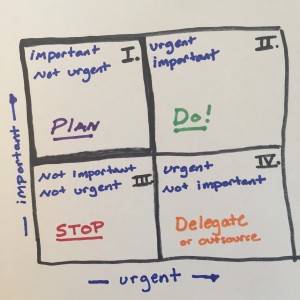
Becoming a Servant Leader Through Strategic Thinking
Last week I gave a sketch of the Eisenhower Matrix, which has challenged leaders to focus on the most important things and to not allow the urgent to dominate and derail them. As a reminder, here is a sketch of the matrix:
While many leaders have been served well with the thinking behind the framework, as Christians we must view the matrix through the lens of our faith.
We are servants first.
Without understanding your identity as a servant, leaders (myself included) can use the “important but not urgent” category as an excuse to isolate themselves and be unapproachable and unavailable to the teams they serve alongside.
Much of ministry to people is unplanned.
My friend Darrin Patrick has said, “The most impactful conversations happen at the most inconvenient times.” Some of the best interactions are not on the calendar. Some of the most holy moments are opportunities disguised as interruptions. Without that understanding, leaders (like myself) can loathe the urgent, and those great opportunities would be missed.
If you approach the matrix with the foundation that you are a servant and that God works in the midst of the urgent, then the matrix can be very helpful. After all, it is possible to be both a strategic leader and a servant leader. One does not need to negate the other. As you think about leading and serving your team, here are three thoughts about serving your team while simultaneously thinking more strategically about your time:
You don’t serve people well if you enable “urgent only” behavior.
There is a difference in being responsive to those you lead and enabling them to live with chaotic urgency. Some decisions and some conversations should not be “drive-by” or “drop-ins” because they won’t receive the focused time they warrant. We are serve our teams well if we help them move strategic conversations out of the urgent box.
The more conversations you move to the “important, not urgent” quadrant, the more energy you have for the “important, urgent.”
The “important, urgent” quadrant is where work gets done, where people are served in the midst of crises, and where we are able to respond to our teams. It is also the space that most overwhelms leaders. By moving some conversations to the “important, not urgent” box, leaders have more mental and emotional energy for the truly urgent.
If you don’t spend time in the “important, not urgent” quadrant, you are not serving the team well for the future
If you only live in the urgent boxes, you are not serving those you lead well. You are not developing yourself, not planning for the future of the organization, not evaluating, not prayerfully considering the development of your team. You are only thinking about today if you don’t invest time in the “important, but not urgent.”
Martin Luther said, “a Christian man is the most free lord of all, and subject to none; a Christian man is the most dutiful servant of all, and subject to every one.” We are servants first because He first served us. But we don’t serve well if we enable unnecessary chaos.

Tags: Eisenhower Matrix, Eric Geiger, servant leader, strategic leader















